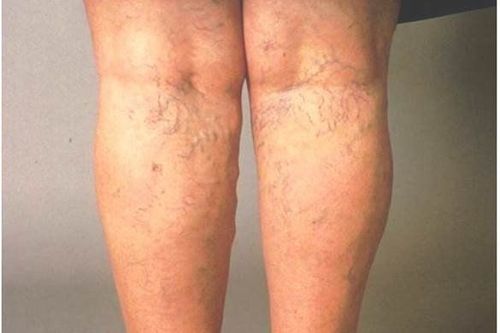This is an automatically translated article.
The article was consulted with Dr. Nguyen Van Duong - Interventional Cardiologist - Cardiovascular Center - Vinmec Central Park International General Hospital.After the acute phase, deep vein thrombosis of the lower extremities still requires continued maintenance therapy along with anticoagulants. Prolonged use of the drug is intended to minimize the chance of recurrent deep vein thrombosis and the development of potentially life-threatening pulmonary embolism complications. The duration of maintenance therapy will be considered on a case-by-case basis, based on whether the risk factors for DVT of the lower extremities continue or have resolved.
1. Early maintenance treatment of deep vein thrombosis of the lower extremities with anticoagulants
Long-term maintenance anticoagulation, for at least 3 months, is an essential component of therapy to prevent the high frequency of recurrent DVT or thromboembolic events. Discontinuing anticoagulation during the first 12 weeks of maintenance therapy tends to result in a 25% recurrence rate of thrombosis. Of these, oral vitamin K antagonists, such as warfarin, remain the preferred indication for long-term treatment, allowing patients to continue to be monitored on an outpatient basis.However, patients with DVT may be recommended to discontinue anticoagulation after 3 months if any of the following are present:
Acute DVT related to surgery Venous thromboembolism caused by a transient nonoperative risk factor First-time illness and high bleeding risk (while in those with low or moderate bleeding risk, a longer duration is recommended) anticoagulation if not contraindicated) Early maintenance treatment of DVT of the lower extremities is with warfarin by disrupting the liver's production of vitamin K-dependent coagulation factors. Because efficacy is delayed for 72 hours until existing circulating coagulation factors are eliminated or exhausted, warfarin is indicated for early maintenance therapy as soon as heparin is initiated in the acute phase. Because, during this period, anticoagulant with heparin is very important to prevent the thrombosis from getting worse. The international normalized ratio (INR) should be maintained at 2-3; Higher rates will not improve anticoagulation, and lower rates will not reduce bleeding complications.
In addition to oral vitamin K antagonists, anticoagulation therapy in early maintenance treatment of DVT of the lower extremities also involves factor Xa inhibitors (eg, rivaroxaban, apixaban) and direct thrombin inhibitors (eg, dabigatran). These new-generation drug classes are also indicated for the prevention of recurrent lower extremity deep vein thrombosis after initial acute therapy; at the same time, allowing doctors and patients to have more treatment options for long-term anticoagulation.
For patients with idiopathic venous thromboembolism in the first episode, the duration of treatment should be 6-12 months. However, the benefit of anticoagulation is lost 1 year after stopping treatment, prompting many physicians to continue treatment indefinitely. Therefore, the decision to continue anticoagulation should be tailored to the individual patient, taking into account bleeding risk and patient preferences, with periodic reevaluation of treatment. With the new generation of anticoagulants, it is no longer necessary to test the coagulation function at each visit, so this can be considered as an outstanding advantage compared to oral vitamin K antagonists, suitable for Long-term patient compliance is recommended.

2. Limitations of anticoagulation therapy in early maintenance treatment of deep vein thrombosis of the lower extremities
Anticoagulants, while strictly adhered to the indications, still have their limitations.Although drugs can inhibit thrombus propagation, anticoagulants do not eliminate thrombosis and a clinically significant increase in bleeding risk can be observed. In 2-4% of patients, deep vein thrombosis progresses to symptomatic pulmonary embolism despite initial anticoagulation. In the group of patients with pulmonary embolism in particular, 8% of patients relapsed despite anticoagulation, 30-45% of which died.
In addition, although early maintenance treatment of DVT with anticoagulants markedly reduces the risk of pulmonary embolism and VTE recurrence, the drug did not reduce the incidence of the syndrome. after thrombosis. As such, the patient still requires prompt removal of the existing thrombus without damaging the underlying venous valves by other physical measures, including compression stockings and surgery.
3. Early maintenance treatment of deep vein thrombosis of the lower extremities in specific patient groups
Cancer patientsThe presence of malignancy is a strong and independent risk factor for the occurrence of VTE in general and DVT of the lower extremities in particular. The incidence reported in cancer patients varies widely and is highly dependent on a number of patient-, treatment-, and cancer-related risk factors. The presence of venous thrombosis has an adverse effect on the malignancy process and further increases the morbidity and mortality of cancer patients.
At this point, the early maintenance treatment of DVT in the lower extremities is more challenging in cancer patients than in those without cancer, because both are more likely to develop recurrent thrombosis. Even with anticoagulation and moderate bleeding, there is an increased risk of bleeding.
In this setting, the experts recommended early maintenance treatment of DVT with low-molecular-weight heparin for at least six months. This recommendation is based on evidence of the superiority of low-molecular-weight heparin over oral vitamin K antagonists. Nevertheless, the decision to continue anticoagulation in cancer patients should be re-evaluated at regular intervals considering bleeding risk, quality of life, life expectancy, and patient choice.
However, with the advent of new generations of oral anticoagulants, benefits in cancer patients are also recognized, making antithrombotic treatment simpler, instead of needing continuous subcutaneous injections. with low molecular weight heparin.

Pregnancy is associated with a twofold increased risk of developing lower extremity deep vein thrombosis compared with non-pregnant women. At the same time, the complication of pulmonary embolism is also common in pregnant women.
At this time, only low-molecular-weight heparin, which does not cross the placenta, is the treatment of choice for pregnant women with venous thrombosis, including deep vein thrombosis of the lower extremities, during the acute phase. and early maintenance treatment. Indicated maintenance dose of weight-adjusted low-molecular-weight heparin should be used during pregnancy and continued for at least 6 weeks postpartum (minimum of 3 months of therapy). . However, in the 24 hours before elective labor, women need to stop anticoagulation, to avoid the risk of excessive blood loss during delivery.
In contrast, oral vitamin K antagonists and new generation drugs are not used for pregnant women because they can cross the placenta, causing embryopathies, especially in the first trimester.
Elderly patients
In elderly patients, the management of venous thrombosis is challenging. Specific problems associated with this population are age, impaired kidney function, reduced body weight, dementia, comorbidities, and increased risk of falls and bleeding risk. .
However, when anticoagulation is indicated after considering the potential benefits outweigh the possible risks, all early maintenance regimens of DVT of the lower extremities, with the exception of dabigatran, are equally applicable to elderly patients. For dabigatran, it should only be used at a reduced dose (110 mg twice daily) in patients 80 years of age and older.
In summary, venous thrombosis is a common and potentially life-threatening condition. Until now, early maintenance therapy with anticoagulation has an undeniable role in preventing recurrence as well as leading to pulmonary embolism complications. However, the choice of anticoagulant drug, the duration of treatment depends on each individual after considering the possible risks when using anticoagulation.

Please dial HOTLINE for more information or register for an appointment HERE. Download MyVinmec app to make appointments faster and to manage your bookings easily.














